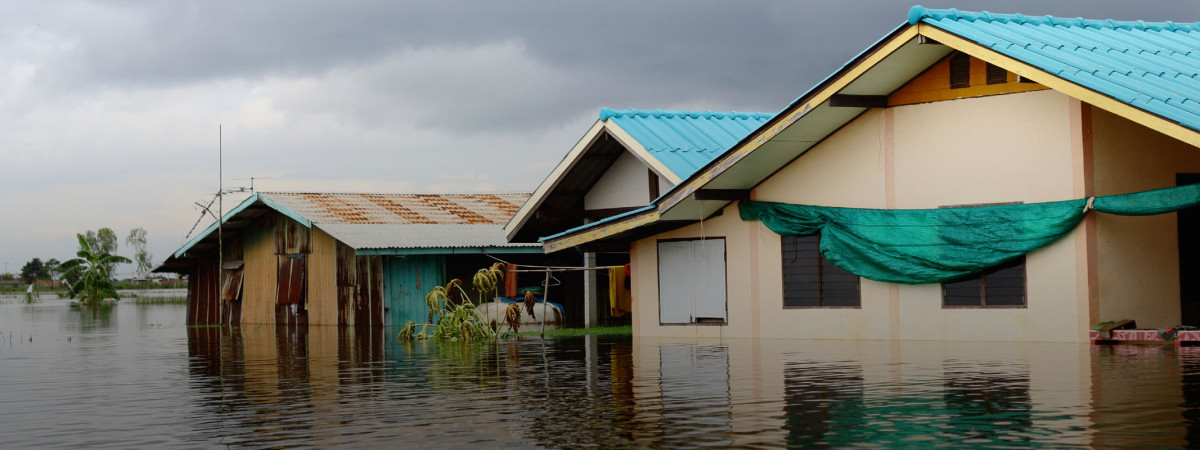
Authors
-
Brooke Avory
Former Manager, BSR
Growing up in drought-affected Australia, and now having spent 18 months in typhoon-vulnerable Hong Kong, I am continually reminded of the effects that climate-induced weather events can have on everyday life.
These conditions affect the private sector, too. Some company leaders are already accounting for how our changing climate affects their operations, and for others, it’s not until a natural disaster takes place that they stand up and pay attention.
As climate change takes greater effect, it will have widespread implications for homes, livelihoods, food security, poverty and conflict, health, and human rights. Companies’ supply chains and transport routes will be disrupted, natural resources will become scarce, and markets will become more volatile. According to the Intergovernmental Panel on Climate Change, the effects will be severe, pervasive, and irreversible.
Thailand is one of the regions threatened by climate change. In 2011, the worst floods in more than 50 years struck the country’s central and northeast regions, disrupting all elements of business and society. The floods had crippling effects on the private sector and, in particular, the manufacturing industry: The production of information and communications equipment, such as hard drives, declined 73 percent in the wake of the flooding.
So, how can businesses help build climate resilience in the areas where they operate?
With support from the Rockefeller Foundation, BSR has published a new report, “Climate Resilience and the Role of the Private Sector in Thailand.” Our report outlines how companies can enhance their capacity to adapt to climate change by investing in the maintenance or restoration of physical, natural, governance, technological, knowledge, social, and financial assets. The report also profiles how four organizations are already building resilience in the country.
In the report, we identify four lessons for business in building climate resilience:
- Incorporate climate resilience-building as one dimension of risk management. For example, climate change and water security can be added as key components of corporate due diligence and risk-assessment protocols. Fujikura integrated climate risk into its business-continuity planning to help build the resilience of its operations. The company also invested in physical assets by enhancing the ability of Thai manufacturing facilities to respond to climate impacts, such as by installing flood protection walls.
- Take a holistic approach to building adaptive capacity. Any approach to building climate resilience should consider the relationship between the company and society, as well as with natural resources, employees, customers, suppliers, and the social license to operate granted by local communities. Prudential partnered with a Thai nonprofit, Foundation for Older Persons’ Development, to train vulnerable elderly citizens in northern Thailand as disaster-response leaders in their communities by teaching others on disaster preparedness. This approach developed both social and knowledge assets: The community increased awareness on how to prepare for natural disasters, and the training process itself helped create stronger social bonds among different groups.
- Find partners in the public and private sectors to collaborate on shared resilience efforts. Sompo Japan Nipponkoa Insurance developed financial assets in the form of weather-derivative insurance products that gave rice farmers in northeast Thailand income stability if rainfall dropped below a predefined level. This work was possible through strong partnerships with Thailand's Bank for Agriculture and Agricultural Cooperatives, the Thai Meteorological Department, and Japan's National Institute for Agro-Environmental Sciences.
- Consider the business opportunities in building adaptive capacity. Tracking corporate costs, investments, and return on investments on climate change adaptation projects can help companies make the business case for investment. Asian Disaster Preparedness Center’s (ADPC) iPrepare Business facility is teaching small- and medium-sized enterprises about the business case for building adaptive capacity in Thailand and how they can make their businesses more resilient in the face of climate change. For example, ADPC provides information to aid corporate decision-making on disaster risk reduction, such as scientific information and data, along with relevant government policies that support disaster risk reduction activities.
As climate change impacts on the private sector become more pronounced, and the risks of inaction affect companies’ long-term sustainability, more companies will find that investing in the adaptive capacity of their operations and the communities around them is a business imperative.
Learn more at the BSR Conference 2015, which features a special track of sessions exploring climate resilience.
Let’s talk about how BSR can help you to transform your business and achieve your sustainability goals.